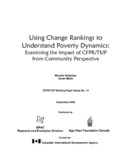Using change rankings to understand poverty dynamics: Examining the impact of CFPR/TUP from community perspective

View/Open
Date
2006-09Publisher
BRAC Research and Evaluation Division and Aga Khan Foundation CanadaMetadata
Show full item recordAbstract
Studies of poverty dynamics relying solely on household income-expenditure surveys can yield noisy results, overestimating transient poverty and underestimating persistence of poverty, especially among the poorest. In this study, we make use of an approach that relies on community-based change ranking to explore various directions and levels of change experienced by almost 6,000 households living in over 100 communities. We find that changes are initial condition dependent and that improvement, even small ones are far less likely to happen over time for the poorest. Traps do seem to exist and matter for the poorest. This suggests that intervention design for the poorest will have to be far more comprehensive including promotional, protective and transformative strategies to make a real dent on extreme poverty. We also argue that most empirical studies of poverty dynamics by focusing on relatively large movements into and out of poverty in different waves miss out on the smaller movements experienced by households. Understanding the extent of and the forces that drive such smaller movements is important as it is the accumulative dynamics of these that ultimately lead to the larger movements of ascent, descent and trap, especially for those at the very bottom, the poorest. Exploring poverty dynamics of the poorest from such ‘small change’ perspective also allows us to develop indicators of incremental graduation to monitor and assess interventions targeted to bring about positive change in the livelihoods of the poorest.
